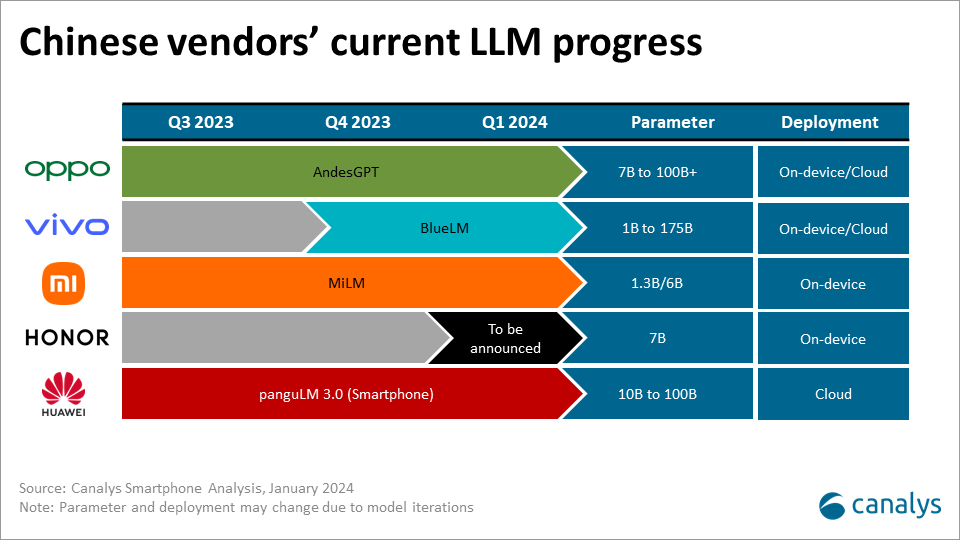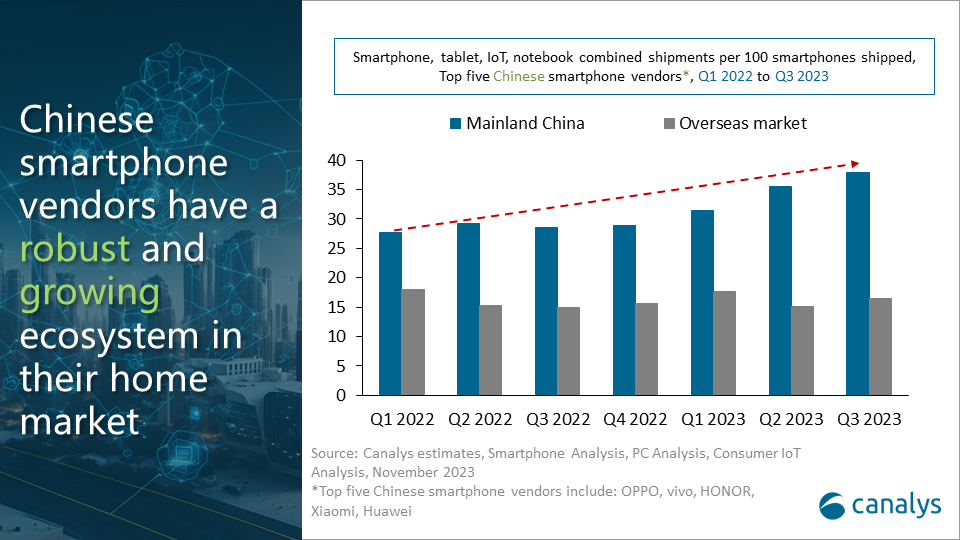ITC ban escalation: Apple’s impending challenges and strategic maneuvers
10 January 2024
Canalys is part of Informa PLC
This site is operated by a business or businesses owned by Informa PLC and all copyright resides with them. Informa PLC’s registered office is 5 Howick Place, London SW1P 1WG. Registered in England and Wales. Number 8860726.

The blog breaks down Chinese local vendors' advantages over their overseas competitors, explores their challenges and discusses their current AI progress and possible next moves.

AI as a key market differentiator
Chinese smartphone vendors are turning to AI as a crucial strategy to stand out in the competitive market. With Huawei's resurgence in the market, the focus is on securing market share and investing in new distinguishing features, with AI taking center stage in this transformation.
AI empowers a more intelligent ecosystem
Chinese vendors, especially those with strong horizontal integration capabilities, are strategically implementing AI into smartphones and across a broader spectrum of products. This includes PCs, wearables, hearables, TVs and even automobiles. The rationale is to build a resilient and interconnected ecosystem where AI plays a crucial role in enhancing the functionality and connectivity of these devices.
New catalyst needed for premium segment growth
Additionally, as Chinese vendors pivot toward a high-end strategy, the market needs a fresh driver beyond technologies like foldable screens and 5G. AI, particularly in the context of processing generative AI models on devices, emerges as a powerful catalyst. It is expected to stimulate a new wave of replacement demands and propel the ASP of devices. This strategic shift toward AI integration is also closely tied to premiumization, making it a driving force in the high-end.
Recently, Chinese smartphone vendors have been proactively investing in in-house LLM developments. Below are several LLMs launched by Chinese vendors which will be integrated into their smartphones. Together with the SoC iterations and aggressive DRAM upgrades in the market, Chinese vendors are increasingly focusing on the on-device AI capability within a hybrid deployment paradigm.
Ecosystem strength in the home market makes AI more powerful for local vendors
Increased attach rate as well as a broader product matrix empowers AI use cases for Chinese smartphone vendors in their home market. Xiaomi, through its MIJIA ecosystem, and Huawei, with HarmonyOS Connect, both have significant user bases in Mainland China. This extends beyond wearables and tablets, which they also offer in the overseas market, to home appliances and even automobiles aided by third parties. The integration of AI will achieve higher usability by addressing a wider range of use cases and ensuring a seamless cross-device experience.

Affordable high-spec device drives on-device AI integration
Chinese vendors are expected to be the first movers to introduce AI-capable smartphones into lower price bands to foster penetration. Local vendors are driven to offer flagship-level hardware at highly competitive price points given the domestic competition, supply chain cost advantage and consumer preference over value-for-money devices. Models equipped with on-device AI capability, designed specifically for generative AI models, will provide a differentiated user experience. Local vendors will gain advantages as overseas vendors struggle to offer the same on-device AI experience within the mid-end segment due to performance restrictions.
Localized operation is the key to thriving AI applications
Local vendors with solid brand appeal, for example, Huawei, stand to gain a competitive advantage by forging close collaborations with local developers. Recently, Mainland China's software giants (such as Meituan and Alibaba) have been working proactively with Huawei to develop native apps specifically for the in-house HarmonyOS NEXT operating system which will be independent of Android's app ecosystem. The same case could happen when integrating Huawei's in-house generative AI models into third-party apps. This collaboration is poised to establish a competitive edge by delivering a differentiated and enhanced experience in AI-powered apps.
Chinese vendors have already started to build AI leadership by investing in R&D capabilities as well as kicking off incentive programs for third-party developers and we believe following the key initiatives outlined below can provide a clearer roadmap for capitalizing on the burgeoning AI-capable smartphone trend and its potential business benefits.
Canalys clients can access the full report for an in-depth analysis of the above initiatives discussing how smartphone vendors can navigate the challenges.